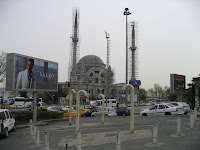Apr 9-13
After a reasonably-comfortable twelve-hour overnight bus ride from Göreme to Istanbul and then a "service" (smaller bus) to Taksim, Chris met me and we walked to his comfortable but simple apartment with a beautiful view of the Bosphorus. He lives in a great neighborhood, hillier than San Francisco. Soon after arriving, I started feeling sick, and would be laid low for the next few days as I slowly recovered. This would be my only sickness of the entire trip!
Day 72 was the half-way point of my trip, day 144 being when I fly from Ireland to Philadelphia. It's hard to believe that I'm only half way done. But the second half of my trip will be a reviving change, touring with Chris, reuniting with Jess, and spending longer periods in more familiar places and cultures.
Istanbul is an incredible and historic city, with one foot in Asia and another in Europe, divided by the Bosphorus which is heavily trafficked by international shipping. It has a population of around 16 million, grown immensely by recent immigration, mostly from the rest of Turkey. The architecture is similar to other European cities I've visited, but filled with some very old structures including mosques, churches, falling down wooden Ottoman houses, and city walls. Cute cats fill the city, taken care of and sometimes taken in by residents.
Chris toured me around as I had strength, being revived by tea (either the standard black tea with sugar or the non-caffeinated apple tea) at a tea and hookah-smoking garden.
I spent Friday visiting two of the main sites: the Blue Mosque and the Aya Sofia. Friday is the Muslim holy day, so there were a lot of people out at the mosques. It also happened to be the time of the tulip festival. The Blue Mosque is distinguished by its blue tint and six minarets, very gaudy and rare (most mosques have one to four minarets). Inside was quite impressive, but not as much as the mosque I visited in Ankara. The Aya Sofia was much more impressive. It's about 1500 years old, 500 years older than the temples at Angkor, and yet has very advanced architecture providing for a huge open space under arched and domed ceilings. Originally constructed as a church, it was later converted to a mosque by the Ottomans like many others in the city. This made for a surreal effect, with large disks displaying names of Muslim prophets in ornate Arabic script next to frescoes of Mary and Jesus. When converting a church to a mosque, a minbar is added, which indicates the direction of mecca. This is almost always haltingly off from the overall orientation of the church. With all the symmetry of churches, the minbar is a startling and central addition. During Ataturk's time, he converted the Aya Sofia to a museum.
Blue Mosque:
Aya Sofia:
Another day, I took the ferry across the Bosphorus to Üsküdar on the Asian side of Istanbul. Üsküdar happens to be the title of the piece Chris is working on, inspired by an experience he had there. I walked along the water past fisherman and people enjoying the day, gazed across the water to the European side including the Blue Mosque and Aya Sofia, and then wandered through some neighborhoods and a bustling market. In the distance of the photo with the big ship, you can see the one bridge across the Bosphorus, connecting the European and Asian sides.
I got to hang out with some of Chris' friends, including a dinner out of mezes and kebaps of meat followed by a stop at their favorite local dive bar featuring metal music, goth ambiance, and edgy, black fanny-pack-wearing waiters. Another evening, a few of us went over to someone's house and made a variety of Turkish dishes and played Tavla (backgammon), the national game. Chris has a good group of friends, and loves living in Istanbul.


























No comments:
Post a Comment